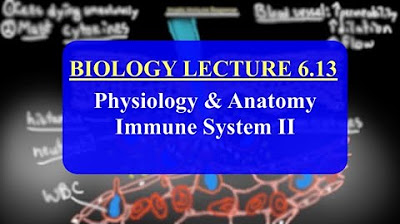Aula: Imunologia - Sistema Complemento | Imunologia #8
Summary
TLDRThis educational video delves into the intricacies of the complement system, a crucial yet complex aspect of innate immunity. The presenter breaks down the topic into three activation pathways: classical, alternative, and lectin, highlighting the system's role in pathogen destruction and immune response enhancement. With the aid of animations, the video simplifies the complex process, emphasizing the importance of understanding this often-overlooked component of immunology.
Takeaways
- 😀 The video is a continuation of immunology lessons focusing on the complement system, a complex and often challenging topic.
- 🧬 The complement system is composed of around thirty inactive proteins that circulate in the bloodstream and play a significant role in the immune response.
- 🏥 It is part of the innate immune system and does not differentiate between previously encountered pathogens and new ones, but can be dependent on the adaptive immune system's response.
- 🔪 The complement system destroys infected cells and pathogens, produces molecules that enhance immune response, and can directly attack pathogens, unlike antibodies.
- 🍌 The proteins of the complement system are likened to bananas, where both the fruit and the peel have uses, symbolizing the multifunctionality of the system's components.
- 🌐 The complement system operates through three pathways: the classical pathway, the alternative pathway, and the lectin pathway, each initiated differently.
- 🔬 The classical pathway requires the interaction of antibodies with antigens and is initiated by the binding of C1 to antibodies, leading to a cascade of reactions.
- 💉 The alternative pathway does not require antibody-antigen interaction and begins with the spontaneous cleavage of C3, which then binds to the pathogen's surface.
- 🍂 The lectin pathway starts with the binding of mannose-binding lectin (MBL) to specific sugars on the surface of pathogens, similar to the classical pathway but initiated differently.
- 🚑 The final common pathway of all three involves the formation of the Membrane Attack Complex (MAC), which creates pores in the pathogen's membrane, leading to its destruction.
- 📚 The video emphasizes the importance of memorization due to the complement system's complexity and the need to understand its role in the immune response.
Q & A
What is the main topic of the video script?
-The main topic of the video script is the complement system in immunology.
Why is the complement system considered difficult to understand?
-The complement system is considered difficult to understand due to its complexity and the need to memorize many details, as it involves a cascade of reactions with numerous proteins.
What is the complement system defined as in the script?
-The complement system is defined as a set of thirty inactive proteins that circulate in our bloodstream, which are activated when necessary to play a role in the immune response.
Why is the complement system considered part of innate immunity?
-The complement system is considered part of innate immunity because it does not differentiate between pathogens it has previously encountered and those it is encountering for the first time; it attacks all equally.
What are the main functions of the complement system as described in the script?
-The main functions of the complement system include destroying infected cells and pathogens, producing molecules that enhance the immune response, and attacking pathogens directly, which antibodies do not do.
What is the MAC complex and what does it do?
-The MAC (Membrane Attack Complex) is a complex of proteins that forms a pore in the plasma membrane of a pathogen, allowing water to enter and leading to the pathogen's lysis (osmotic lysis).
What are the three pathways of the complement system mentioned in the script?
-The three pathways of the complement system mentioned in the script are the classical pathway, the alternative pathway, and the lectin pathway.
What is the role of C3 in the complement system?
-C3 plays a central role in the complement system by being involved in the activation of the cascade of reactions in all three pathways. It is cleaved into C3a and C3b, which participate in the formation of the MAC and other immune responses.
How does the alternative pathway of the complement system differ from the classical pathway?
-The alternative pathway differs from the classical pathway in that it does not require the interaction of antibodies with antigens. It starts with the spontaneous cleavage of C3 and its subsequent binding to the surface of a pathogen.
What is the role of C5a in the immune response as described in the script?
-C5a is a potent anaphylatoxin that attracts mast cells and basophils to the site of infection, causing them to release histamine, which in turn leads to vasodilation and facilitates the arrival of more immune cells to the site.
What is the importance of the complement system in the immune response, according to the script?
-According to the script, the complement system is crucial in the immune response as it destroys pathogens, enhances the immune response by producing molecules that attract immune cells, and directly attacks pathogens, making it a vital component of the body's defense mechanisms.
Outlines

هذا القسم متوفر فقط للمشتركين. يرجى الترقية للوصول إلى هذه الميزة.
قم بالترقية الآنMindmap

هذا القسم متوفر فقط للمشتركين. يرجى الترقية للوصول إلى هذه الميزة.
قم بالترقية الآنKeywords

هذا القسم متوفر فقط للمشتركين. يرجى الترقية للوصول إلى هذه الميزة.
قم بالترقية الآنHighlights

هذا القسم متوفر فقط للمشتركين. يرجى الترقية للوصول إلى هذه الميزة.
قم بالترقية الآنTranscripts

هذا القسم متوفر فقط للمشتركين. يرجى الترقية للوصول إلى هذه الميزة.
قم بالترقية الآنتصفح المزيد من مقاطع الفيديو ذات الصلة

Immunology | Immune System: Overview

Complement System Made Easy- Immunology- Classical Alternate & Lectin pathway

IMAT Biology Lesson 6.13 | Anatomy and Physiology | Immune System Part II

Types of immune responses: Innate and adaptive, humoral vs. cell-mediated | NCLEX-RN | Khan Academy

Imunologia: conceitos básicos (Aula 1)

Humoral Immunity | The B-Lymphocytes | Immunology | Physiology
5.0 / 5 (0 votes)
